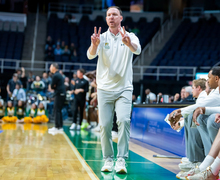CTLE conversation helps SU faculty navigate ‘AI misuse’
Maxine Brackbill | Photo Editor
In the Schine Student Center, Syracuse University faculty discuss different ways AI affects classroom learning. Discussion leaders, Roger Hallas and Laura Lisnyczyj, pulled up different web-based AI resources that students often use for assignments.
Get the latest Syracuse news delivered right to your inbox.
Subscribe to our newsletter here.
Syracuse University’s Center for Teaching and Learning Excellence held a “Setting and Managing Boundaries for Students’ Use of Artificial Intelligence” conversation Wednesday afternoon, which looked to foster open conversation among SU faculty about the emerging prominence of AI in education.
During the event, CTLE hosted two keynote speakers — Roger Hallas, an associate professor in the English department and Laura Lisnyczyj, an assistant teaching professor in the languages, literatures and linguistics department — to speak about their experiences interacting with AI as instructors. Around 25 faculty attendees also discussed how they are navigating the changing AI landscape.
Throughout the presentation, Hallas highlighted three areas of inquiry: setting expectations, developing AI-resistant assignments and the dynamics of AI detection. Hallas said transparency around AI is important in ensuring students have a clear idea of what is allowed in class.
“Whatever you decide, in terms of whether AI cannot be used in any context, whether AI can be used in some context, whether AI is going to be specifically engaged with in assignments … be clear upfront about those expectations,” Hallas said, “because transparency in curriculum and syllabi is a major issue of accessibility.”
Hallas also explained strategies to create “AI-resistant assignments,” such as utilizing close reading, assignments that revolve around students’ personal experiences and creating assignments with “scaffolding” — where students submit drafts and edits of their work over time.
Hallas said that students tend to “misuse” AI resources when facing hard deadlines, which often results in procrastination.
Hallas said dealing with AI detection and accountability is “mentally and emotionally draining” for both the student and instructor, which is why he tries to tackle issues of AI detection without “breaking the trust between student and teacher.”
“What I ask the students to do is to talk about their process. How did you come up with the idea of this paper, so rather than go in with ‘Your ChatGPT score is 87%, how do you account for that?’ (work) through how they got the idea of the paper,” Hallas said.
An SU resource webpage, last updated in January, established guidelines for AI usage in the classroom. Many schools at SU, such as the College of Engineering and Computer Science and the School of Information Studies, have implemented AI in their classrooms. The iSchool additionally launched a class on AI titled Information Studies 300: AI and Humanity in the fall 2023.
Lisnyczyj, who teaches and frequently works with non-English speaking students, spoke about the impact AI translators like DeepL — an AI tool that creates incredibly accurate translations — have on education.
Many students who feel their English isn’t “strong enough” to articulate their ideas rely on AI translators, Lisnyczyj said. She said the resource can be useful to help students gain an understanding of a given text when used in moderation.
“As non-native speakers, obviously, a lot of the text that they have to read is dense, and so they have that extra challenge,” Lisnyczyj said. “I say (to my students), if that is going to help you, you should still read it in English after, because then you’re learning the vocabulary that’s necessary for that topic … but at least you’ll have the understanding.”
After the presentation, the panelists opened the floor for attendees to share their experiences navigating AI in the classroom. Attendee Moira McDermott, an associate teaching professor of mathematics, said she agreed with Hallas that students tend to use AI when they have procrastinated on their work.
McDermott said addressing and preventing students’ procrastination is crucial in preventing AI abuse in a classroom.
“I remind them every week (to) make sure that (they) take a look at the assignments when they come out,” McDermott said.
Sebastian Tideman-Frappart, another attendee and an assistant professor of accounting at SU’s Martin J. Whitman School of Management, said he holds a different perspective on AI tools in education than the panelists.
Tideman-Frappart said it is important to remember the potential benefits of AI, such as how it can accelerate basic tasks so students can focus more on the details. Because AI is going to be a prominent tool in many students’ future careers, he said he would encourage faculty to implement assignments that cultivate responsible AI usage.
“AI is primarily a tool, right? Like if I think about the business students, that’s huge … they’ll be exposed to AI and things are changing,” Tideman-Frappart said. “They’ll have those tools available. So, for us as instructors, it’s our task to teach them how to use them.”
Published on February 28, 2024 at 11:05 pm






